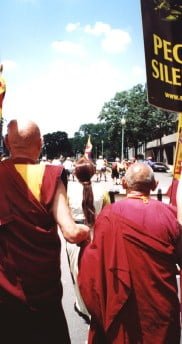Last year I visited Tibet. The trek began in a four-wheel-drive Jeep traveling throughout the eastern and central portions of the Tibetan Plateau. Thinking back, I believe it took me a couple of weeks just to settle down after coming to such a strange, distant, and enchanting land.There were high snow mountain passes and expanses of valley floor so open I felt my mind widening within them. The people inhabiting the rural areas were mainly nomads. They live by herding yak and goats through the mountains. If I tried to take their picture, they would run away, scared of the strange device pointed at them.
Some people in rural villages seemed to have little or no experience with Westerners. The kids of the village followed at a distance behind me very excitedly, yet ran if I stopped and tried to shake their hands. I picked up three stones and, from a distance, taught them how to juggle.
Tibet’s monasteries were like diamonds looming out of coal. The drive sometimes took 12 hours rolling through the uninhabited, untainted, pure snow land. Suddenly a monastery appeared as if by magic, bedecked in ornate paint and carvings and architecture that was stunningly beautiful. There was a feeling of innocence and untouched beauty. It made the other facet of Tibet’s history hard to see.
Next to every rebuilt monastery was broken rubble where the Chinese had destroyed the old buildings in the Cultural Revolution. I made out destruction on hillsides from miles away. Some monasteries were only half built, needing money for completion. The Tibetan people are trying to rebuild what the Chinese shattered.
I visited a temple that once housed thousands of monks but now only had 60. I met with a very old monk who had lived through the Cultural Revolution; he looked tired and sad. He did not want me to take his picture. He seemed broken.
I was not allowed to sleep in monasteries, for Chinese fear that the Tibetans might tell travelers stories they did not want leaked out. I wasn’t allowed to travel anywhere without a Chinese licensed guide and an expensive permit.
Tibetans would come up to me when my guides were not around and ask me to tell the world they wanted their freedom; some would ask us for a picture of the Dalai Lama, their Nobel Peace Prize winning spiritual teacher whose image has been banned by the Chinese.
I saw beautiful roads from Lhasa’s airport, frequently traveled by Chinese government officials on tours of Tibetan land in bright shiny new model Land Cruisers. I traveled hideous roads to visit the Karmapa, whom the Tibetans consider as one of the most important people of their society.
In “developing” Tibetan towns, I was amazed at the wealth of shops with Chinese signs and the similarities to the filthy polluted cities of China they were slowly turning into.
The Chinese turned the Potala Palace, one of the Tibetans’ most sacred places, into a museum. They have found Tibetan Buddhism serves one good purpose –tourist dollars — and they will make you pay to go into a monastery when they can.
Tibetans who speak out for freedom are jailed. In jail they are starved and tortured. Monks are forced to attend Chinese “re-education” seminars where they are told propaganda and lies about their exiled leaders and their history.
Tibetans live in fear of the huge army outposts that lie on the outskirts of most major towns. They told of their hopelessness in the face of such a formidable enemy. They fought against the Chinese in the beginning of the takeover in the ‘50s and 60s and were slaughtered. Now their only hope comes from the outside.
Everywhere I looked I was inspired by the beauty of this culture, yet devastated by the amount of violence and destruction that has been and is being put upon these peaceful people. I left Tibet on a spiritual high, and at the same time was deeply saddened at what I saw; the pillaging of natural resources, deforestation, pollution, and sacrilegious intentions of China.
After coming back to the States, my trip became more and more like a dream. Yet, when I heard about a Tibetan Freedom March in Washington D.C. this past summer, I felt the need to go.
The march started with a rally. Monks and nuns tortured in Chinese prisons spoke of loving the Chinese. Their deep belief in karma makes them understand that the Chinese are really only hurting themselves. Their deep commitment to compassion makes them wish to help all beings.
Youthful Tibetans lead chants with the crowd screaming, “Tibetan Freedom NOW.” A Nobel Peace Prize winner from Ireland spoke of her life working for the freedom of Northern Ireland, of “never resorting to violence.”
After the rally, the march through the city began. There were thousands of people with flags and banners shouting for Tibet’s freedom. I ran up to the front because I felt it was the most exciting place to be.
The march went past the World Bank offices chanting for the officials not to give China money to facilitate a transfer of Chinese immigrants into Tibet, past the Chinese Embassy chanting, “Shame on China,” into their open windows, and shouting down the streets; traffic stops, people listen.
While walking my eyes kept falling upon two old monks in front of me. They didn’t chant with the rest of the marchers. They just walked.
One held a small Tibetan flag; one held a small American flag.
One, Palden Gayatso, spoke at the rally. The Chinese tortured him for over 20 years of his life, and, upon his release, he bribed the guards to give him the instruments used in his torture. Now he travels around the U.S. and exhibits his wares at talks.
The march suddenly went under a tunnel that undercuts a busy street. I looked again at the two monks in front of me; they were holding hands.

